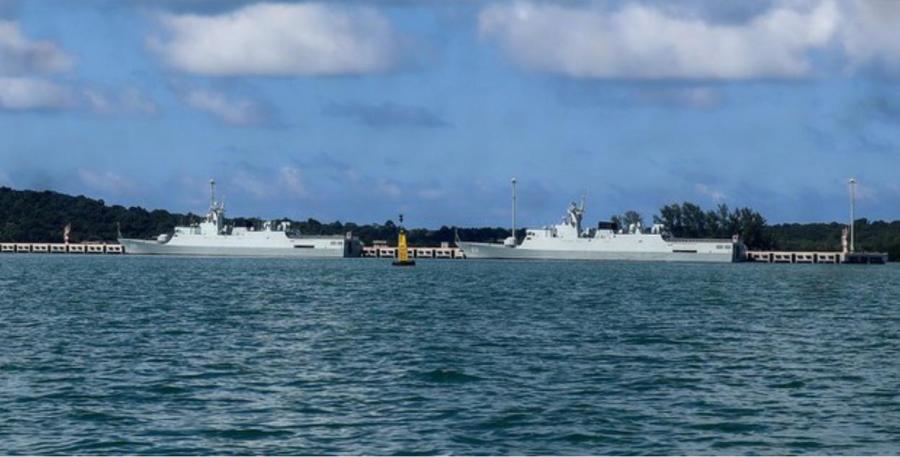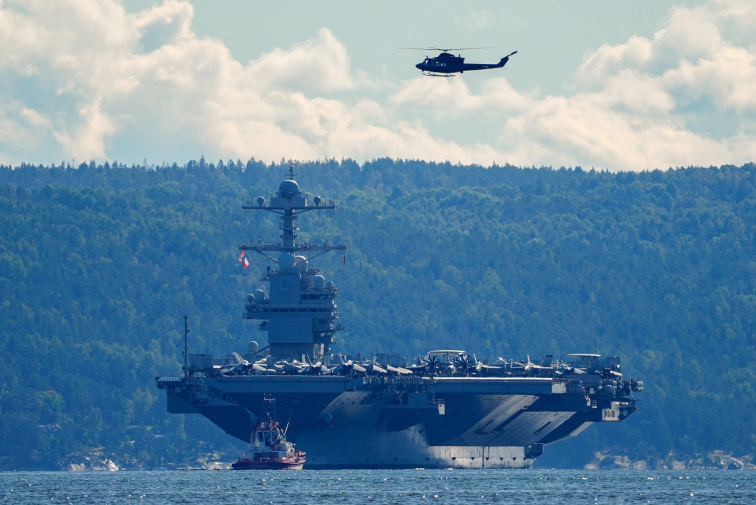The image shows two Chinese Navy Type 056A missile frigates docked at Cambodia's Ream Naval Base in August 2024.
[People News] Recently, a report from CNN peeled back the glittering façade of the Chinese navy’s purported power.
CNN Exposes Design Flaws in the Fujian Carrier
On October 25, 2025, CNN cited two retired U.S. Navy officers—former Captain Carl Schuster and retired Lieutenant Commander Keith Stewart—who analyzed photos and video footage of China’s Fujian aircraft carrier. They concluded that its flight deck layout suffers from major design defects that drastically reduce operational efficiency—performing at only about 60% of the level of the U.S. Navy’s 50-year-old Nimitz-class carriers.
The report noted fatal flaws in the deck layout:
the landing area is angled too close to the forward catapult, and the landing runway extends too far forward, leaving cramped deck space and creating high risk of collision during aircraft movement. This makes it impossible to launch and recover aircraft simultaneously, a fundamental requirement for modern 80-100-thousand-ton “supercarriers.”
Both Schuster and Stewart agreed: this layout limits the Fujian’s operational tempo to about 60% that of a Nimitz-class carrier.
Ironically, this issue was first discovered by a Chinese military blogger analyzing a state-TV documentary.
On August 5, 2025, CCTV aired a program titled “Assault—Determined to Build a World-Class Military.” A blogger using the handle “Maritime Pioneer” scrutinized screenshots from the program and found inconsistencies in the deck design.
“Maritime Pioneer” observed that the No. 2 catapult’s track overlaps the end of the angled landing runway; the No. 3 catapult sits on the inner side of the landing strip; even the No. 1 catapult, though not directly overlapping, must be crossed by landing aircraft taxiing to the maintenance area.
These overlaps mean that whenever aircraft land, none of the three catapults can be used simultaneously, crippling operational efficiency.
Analysts believe the root cause lies in the Fujian’s design evolution: it was likely originally designed for a 70-meter steam catapult and later switched to 100-meter electromagnetic catapults (EMALS) without fully adjusting the deck layout, creating spatial conflicts. The designers may have optimized for single-wave sortie capacity, sacrificing flexibility.
CNN confirmed these problems and attributed them to China’s lack of carrier experience—the U.S. has over 80 years, while China has barely a decade. Schuster bluntly said the Fujian is “a test platform, not a combat weapon.”
By comparison, the U.S. Nimitz and Ford classes have well-spaced landing and launch zones, enabling high “cyclic operation” rates and overwhelming air dominance. The Fujian’s efficiency, at only 60%, means that in a potential Taiwan or South China Sea conflict, Chinese carriers would struggle to counter U.S. massed air attacks.
Multiple Weaknesses: Reverse Engineering and Espionage
The Fujian’s power system is another major limitation.
It uses conventional diesel/gas-turbine propulsion with a range of only 8,000–10,000 nautical miles, requiring frequent refueling.
By contrast, the U.S. Ford class uses nuclear power—nearly unlimited range, capable of 20 years of continuous sailing.
This underscores the strategic limits of the PLA Navy, confined to regional operations with little capacity for global power projection. If fuel supplies are cut, the Fujian becomes a sitting duck.
Its air wing is also inferior—only 40–50 aircraft, mostly J-15 and J-35 fighters, lacking dedicated electronic-warfare planes or diverse configurations.
The Ford class carries 75 F-35C stealth fighters, forming a full combat wing.
China’s carrier air wing is two-thirds the size and far less stealthy—incapable of matching U.S. naval aviation.
Questions also persist over technological maturity.
Though Chinese media boast that EMALS on the Fujian has a failure rate below 0.2% (better than the early U.S. system), it remains untested in combat.
The Ford class overcame early malfunctions through years of refinement; China’s system, derived via reverse engineering and suspected cyber-espionage, may prove unreliable under battlefield stress.
Indeed, China’s entire carrier fleet—Liaoning, Shandong, and Fujian—shares similar issues: limited experience, small fleet size, and weak support structure. Escort ships are numerous but poorly coordinated, incapable of forming a cohesive strike group. Against new threats like drones and hypersonic missiles, the PLA Navy’s defense network could easily be overwhelmed.
Despite Beijing’s claims of “independent innovation,” the reality is a hybrid built on stolen and imported technology.
-
The Liaoning was purchased unfinished from Ukraine in 1998 under the guise of a civilian project; its hull and ski-jump deck came directly from Soviet designs.
-
The carrier-borne J-15 was reverse-engineered from Ukraine’s Su-33 prototype.
-
Ukraine provided hull and technical support; Russia supplied the arresting-gear system.
-
The Shandong merely refined these features—a “second generation” of Soviet-Ukrainian technology.
-
The Fujian’s EMALS resembles that of the U.S. Ford class but, according to U.S. Department of Defense reports, was likely acquired through cyber-espionage.
Xi Jinping Losing Grip on the Military: A Deep Political Crisis
The CCP’s military system has long been riddled with corruption, often worse than civilian bureaucracy.
Since Xi Jinping took power, his “anti-corruption campaign” has swept through the military—but the more he purges, the more corruption spreads. Behind the façade, Xi has used these purges to eliminate political rivals, provoking fierce resistance inside the army.
Xi’s most formidable adversary within the military today is CMC Vice-Chairman Zhang Youxia.
On October 17, 2025, three days before the Fourth Plenary Session, the Defense Ministry announced the expulsion of nine full generals, including Vice-Chairman He Weidong, CMC member Miao Hua, and Armed Police Commander Wang Chunning.
Most were personally promoted by Xi and held key posts in the Rocket Force, Navy, and Armed Police.
The Plenum later confirmed the expulsion of 14 Central Committee members, nine of them senior military officers.
Out of 42 military Central Committee members, 27 were absent—a 63% absence rate.
Of 33 full generals, 22 were absent—8 purged, 14 “missing.”
Nearly all theater and service commanders or political commissars have been wiped out.
On October 25, former Central Party School professor Cai Xia publicly revealed that Miao Hua and He Weidong had secretly formed an armed unit in the Langfang region of Hebei, triggering widespread speculation.
Former Inner Mongolia official Du Wen, on his YouTube channel, said he spoke with Cai Xia for 80 minutes to verify the claim.
Both concluded the creation of such a unit was entirely plausible, citing Langfang’s numerous naval installations and the closed, compartmentalized nature of China’s military system, which prevents external oversight.
They explained that, under CCP rules, local officials cannot interact freely with military officers—making it possible for such a secret unit to exist undetected.
Where did the manpower, weapons, and funding come from?
They reasoned that it couldn’t have come from new recruits or veterans, as those are tightly managed.
The only logical explanation: He Weidong, leveraging his power as CMC vice-chairman, issued direct transfer orders pulling personnel, weapons, and logistics units from other forces into Langfang—each group isolated and forbidden to communicate.
They surmised this brigade-level unit was composed of handpicked loyalists.
However, Du Wen also suggested Xi might still hold ultimate control.
If He Weidong and Miao Hua formed this force without Xi’s knowledge, they were likely reported by political rivals—possibly accused falsely of plotting a coup.
Thus, He may not have been anti-Xi but framed for mutiny.
Still, Du Wen conceded another interpretation makes more sense: the secret unit was built with Xi’s approval, by He and Miao, to protect Xi personally—or even to counterbalance Zhang Youxia’s faction.
Recently, Xi’s trusted aide Zhong Shaojun was dismissed as Political Commissar of the National Defense University.
Observers note Xi’s repeated purging of close military aides seems self-defeating—raising the question: why? Is it mere authoritarian caprice? A show of power? Clearly, something deeper is at play.
The reality: the PLA is now mired in a profound political crisis.
The Xi–Zhang power struggle has likely only just begun.
(First published by People’s Daily)
△










News magazine bootstrap themes!
I like this themes, fast loading and look profesional
Thank you Carlos!
You're welcome!
Please support me with give positive rating!
Yes Sure!